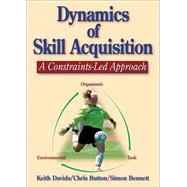
Note: Supplemental materials are not guaranteed with Rental or Used book purchases.
Purchase Benefits
| Preface | p. vii |
| Acknowledgments | p. xi |
| Introduction to Skill Acquisition Theory and the Constraints-Led Approach | p. 1 |
| Traditional Theories of Skill Acquisition | p. 3 |
| Skill Acquisition: Definition and Theories | p. 4 |
| Common Features of Traditional Theories | p. 17 |
| Implications for Movement Practitioners | p. 21 |
| Summary | p. 27 |
| Physical Constraints on Coordination: Dynamical Systems Theory | p. 29 |
| Complex Systems: A Definition | p. 30 |
| Constraints on Complex Systems | p. 32 |
| Emergent Behavior in Human Movement | p. 36 |
| Constraints and Movement Coordination | p. 39 |
| Interacting Constraints | p. 42 |
| Coordination Processes in Human Movement Systems | p. 43 |
| Functional Role of Variability in Movement Systems | p. 48 |
| Summary | p. 51 |
| Informational Constraints on Coordination: An Ecological Perspective | p. 55 |
| Ecological Psychology and Information | p. 56 |
| Information-Movement Coupling | p. 65 |
| Haptic Information Constraints on Movement | p. 73 |
| Acoustic Information Constraints on Movement | p. 75 |
| Summary | p. 78 |
| Redefining Learning: A Constraints-Led Approach | p. 81 |
| The Perceptual-Motor Landscape | p. 82 |
| Newell's Model of Motor Learning | p. 85 |
| Practical Issues for Learning | p. 94 |
| Role of the Movement Practitioner: Nonlinear Pedagogy | p. 98 |
| Hands-Off Practitioners | p. 99 |
| Summary | p. 101 |
| Applying the Constraints-Led Approach | p. 105 |
| Understanding the Dynamics of Skill Acquisition | p. 107 |
| Constructing the Perceptual-Motor Landscape | p. 108 |
| The Practitioner's Perspective | p. 117 |
| Summary | p. 126 |
| Dealing With Individual Differences: Implications for a Nonlinear Pedagogy | p. 129 |
| Intrinsic Dynamics of the Movement System | p. 130 |
| Variation in Athletic Performance | p. 133 |
| Individual Differences in Practical Settings | p. 141 |
| Developing Decision-Making Skills | p. 147 |
| Summary | p. 150 |
| Organizing Practice to Optimize Learning | p. 153 |
| The Constraint of Time in Practice | p. 154 |
| Manipulating Task Constraints in Practice | p. 157 |
| Strategies for Structuring Practice | p. 164 |
| Summary | p. 169 |
| Using Verbal Guidance as an Informational Constraint on Learners | p. 173 |
| Effectiveness of Verbal Communication Strategies | p. 174 |
| Verbal Communication as a Temporary Informational Constraint | p. 178 |
| Attentional Focus and Verbal Communication | p. 178 |
| Interaction of Verbal Instructions and Feedback | p. 184 |
| Verbal Communication and Movement Disorders | p. 186 |
| Summary | p. 187 |
| Observational Learning as Directed Search | p. 189 |
| Directed Search and Observational Learning | p. 190 |
| Observational Learning in Social Contexts | p. 192 |
| Visual Perception Perspective on Observational Learning | p. 194 |
| Learner-Regulated Video Feedback | p. 202 |
| Summary | p. 204 |
| Implementing the Constraints-Led Approach: Case Studies | p. 207 |
| Practice and an External Focus of Attention | p. 208 |
| Dynamics of Learning the Soccer Chip | p. 210 |
| Individual Differences in Amputee Gait | p. 212 |
| Practice Organization for Soldiers | p. 215 |
| Instructions for Student Drivers | p. 217 |
| Modeling to Direct Students' Learning | p. 219 |
| Glossary | p. 223 |
| References | p. 227 |
| Index | p. 247 |
| About the Authors | p. 251 |
| Table of Contents provided by Ingram. All Rights Reserved. |
The New copy of this book will include any supplemental materials advertised. Please check the title of the book to determine if it should include any access cards, study guides, lab manuals, CDs, etc.
The Used, Rental and eBook copies of this book are not guaranteed to include any supplemental materials. Typically, only the book itself is included. This is true even if the title states it includes any access cards, study guides, lab manuals, CDs, etc.